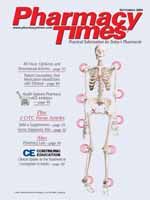Publication
Article
Pharmacy Times
Oral Medication Interactions with Ethanol
Approximately 52% of Americans consumed one ormore alcoholic drinks in the past month.1 At thesame time, prescription drug use has increased to ~10prescriptions per person in the United States.2 It is likely thatmany Americans will use both prescription medications andalcohol, creating the potential for drug?ethanol interactions.It is, therefore, advisable for pharmacists to review medicationsthat may interact with ethanol to enhance patientcounseling and to avoid untoward effects.
Mechanisms of interaction may involve ethanol metabolism.Once ingested, a small percentage of ethanol is metabolizedin the stomach to acetaldehyde by alcohol dehydrogenase(ADH).3 The majority of ethanol is metabolized in theliver by ADH and the cytochrome P450 isoenzyme 2E1.Ethanol is a substrate of isoenzyme 2E1 and an inducer, primarilywith long-term use (short-term use paradoxically producesenzyme inhibition).4,5 Potential mechanisms for druginteractions include changes in enzyme activity, changes ingastric emptying, and additive toxicities.
Pain Medications/Muscle Relaxants
The concomitant use of ethanol and narcoticscauses additive depression of the central nervoussystem (CNS), with impairment of speech, sedation,and lethargy. In the case of propoxyphene, bioavailabilityis increased when it is used with ethanol, likelydue to reduced first-pass metabolism. Nonnarcoticpain relievers, such as tramadol, also mayproduce additive CNS depression.
The interaction of acetaminophen with ethanol islikely due to the induction of CYP2E1 in chronic alcoholusers.4 Enzyme induction increases production ofthe toxic metabolite N-acetyl-p-benzoquinoneimine(NAPQI) and may result in hepatic injury or failure.
The combination of nonsteroidal anti-inflammatorydrugs (NSAIDs) and ethanol may cause gastritis orgastrointestinal bleeding through additive irritation.4Acute renal failure also is possible, secondary to volumecontraction with ethanol coupled with NSAID-inducedchanges in renal blood flow. An increase inbleeding time also can be seen.6
Muscle relaxants such as tizanidine and chlorzoxazonehave additive CNS depression with ethanol.Chlorzoxazone is a CYP2E1 substrate, and its metabolismmay be inhibited by acute ethanol consumptionor induced by chronic consumption.3
Sedatives
The combined use of sedatives and ethanol causesadditive CNS depression and possibly fatal respiratorydepression. Barbiturate metabolism in theliver also may be inhibited in the presence of alcohol,potentiating the pharmacologic effect.
Antianxiety/Antidepressant Drugs
Ethanol inhibits benzodiazepine metabolism, althoughnot all agents are equally affected.7 For example, agentsmetabolized by conjugation reactions (eg, lorazepam) haveunchanged blood levels, whereas levels for agents metabolizedby oxidation (eg, diazepam) are increased. The use ofethanol and benzodiazepines results in additive CNS depression.Other antianxiety agents, such as meprobamate,also may potentiate CNS depression with ethanol.8 Thetyramine content of some wines precludes concomitant useof ethanol with monoamine oxidase inhibitors.
The use of ethanol and tricyclic antidepressants is likely tocause alterations in psychomotor function, including"blackouts." Reduced metabolism of imipramine andamitriptyline has been shown with chronic ethanol use.
Although data are lacking, product manufacturers warnagainst the use of ethanol with selective serotonin reuptakeinhibitors as well as with venlafaxine and nefazodone.9-13Ethanol, when administered with mirtazapine, increasespsychomotor impairment.14 Bupropion lowers the seizurethreshold and, in the setting of abrupt alcohol withdrawal,could produce an additive lowering of the seizure threshold.15
Antihypertensive Agents
Ethanol causes additive vasodilation with such agents asnitroglycerin, methyldopa, and hydralazine.6 In addition,verapamil has been shown to increase blood ethanol levels,presumably by interfering with metabolism.16 High concentrationsof ethanol may reduce the rate of gastric emptyingand increase propranolol absorption.4,17
Anticoagulants
Both ethanol and aspirin have gastrointestinal (GI) irritanteffects, which may contribute to GI bleeding. Additiveprolongation of bleeding time is likely. Aspirin also mayinhibit ADH in the stomach, reducing the first-pass effect ofethanol.
The use of ethanol with warfarin produces variable effectson the international normalized ratio (INR). In chronic alcoholusers, warfarin metabolism may be induced,4 resulting ina lower INR. Acute ethanol use may inhibit warfarin metabolism,increasing the INR.
Antidiabetic Agents
Ethanol is thought to reduce gluconeogenesis and mayaffect the safety of antidiabetic medications.4 Ethanol cancause prolonged hypoglycemia or disulfiram-like reactions(flushing, sweating palpitations, headache) when used inconjunction with sulfonylureas (eg, glyburide, glipizide).Hypoglycemic reactions also are possible in patients treatedwith insulin. Ethanol can enhance the inhibition of lactatemetabolism by metformin.18
Gastrointestinal Agents
In some studies, the histamine 2-receptor antagonistscimetidine and ranitidine produced slightly elevated bloodalcohol levels.4,19 Cisapride and erythromycin may increasethe rate of ethanol absorption by reducing the gastric emptyingtime and first-pass metabolism by ADH.4
Antimicrobial Agents
Many antifungals and antibiotics?including cotrimoxazole,ketoconazole, and griseofulvin?have the potential toproduce a disulfiram-like reaction with ethanol through anunknown mechanism.20 The combination of isoniazid andethanol may cause disulfiram-like reactions, a reduced half-lifewith acute ethanol ingestion, and increased isoniazidmetabolism with chronic ethanol ingestion.21 The potentialfor liver injury with isoniazid also is increased with ethanoluse.4 Metronidazole combined with ethanol may cause adisulfiram-like reaction, although this interaction has beenquestioned.22 The area under the concentration-time curveof tetracycline may be increased with ethanol.4
Antihyperlipidemics
Ethanol consumption can increase lipid levels, causing apharmacodynamic interaction with HMG-CoA reductaseinhibitors and other cholesterol-lowering drugs. Liverimpairment as a result of chronic ethanol use can contributeto reduced metabolism and increased toxicity with theseagents. At least one study involving moderate alcohol consumptionwith fluvastatin found that fluvastatin metabolismand kinetics were altered, although no adverse effectswere reported and efficacy was maintained.5,23
Other Drugs
Other agents that interact with ethanol include amprenavir,24,25 sodium oxybate,26 theophylline,4 acitretin,27isotretinoin,4 procarbazine,28 methotrexate, antipsychoticagents, antihistamines, phenytoin, and carbamazepine.4
It is impossible to predict the individual patient responseto the concomitant use of prescription drugs and ethanol.Avoidance of alcohol, especially in the setting of polypharmacy,is the best way to avoid interactions. Avoidanceshould be strongly recommended in patients with underlyingdisease states aggravated by ethanol, such as gout,hypertension, esophagitis, heart failure, osteoporosis, renaldysfunction, depression, and diabetes.4 If avoidance is notpossible, consumption of a meal prior to ingestion ofethanol is advisable. The use of lower doses of potentiallytoxic agents (eg, acetaminophen) in chronic alcohol usersmay be necessary.
Dr. Hartman is medication safety officer at UMass Memorial MedicalCenter, Worcester, Mass. He also is a clinical assistant professorat Northeastern University and an adjunct assistant professorat Massachusetts College of Pharmacy. Dr. Lowery is a pharmacypractice resident at Brigham and Women's Hospital, Boston, Mass.
For a list of references, send a stamped, self-addressed envelope to:References Department, Attn. A. Stahl, Pharmacy Times,241 Forsgate Drive, Jamesburg, NJ 08831;or send an e-mail request to: [email protected].

Newsletter
Stay informed on drug updates, treatment guidelines, and pharmacy practice trends—subscribe to Pharmacy Times for weekly clinical insights.






